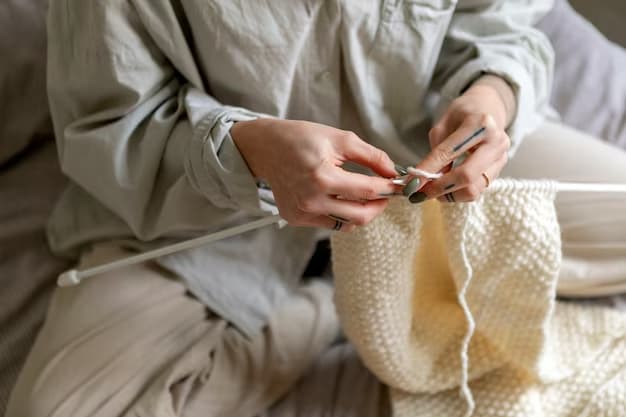Introduction to the German Short Row Heel
The German short row heel, renowned for its durability and fit, is a popular choice among knitters for socks and other footwear. This technique involves creating a series of short rows to shape the heel, resulting in a comfortable and well-fitted garment.
Step-by-Step Instructions for the Heel
Begin by dividing your stitches into three equal sections, using stitch markers for accuracy. If the total stitch count is not divisible by three, allocate an extra stitch to the middle section. For instance, with 26 stitches, divide them into 8/10/8, and for 28 stitches, use a 9/10/9 division.
Starting the Heel
- Row 1: Start by turning your work;
- Row 2: Create a double stitch (mds) at the beginning and purl to the end; turn your work again.
Making a Double Stitch
- Bring the yarn to the front;
- Slip the stitch knitwise with the yarn in front;
- Pull the working yarn tightly to form two loops on the needle.
Continue with rows 3 and 4, alternating between knitting and purling, and decreasing the row length each time by not knitting the double stitch.
Tips for Avoiding Common Mistakes
- Use stitch markers for ease and accuracy;
- Maintain a tight tension on the double stitches to prevent holes;
- For advanced knitters, consider learning to knit backward to avoid frequent turning of the work.
Advanced Techniques for Experienced Knitters
After completing the initial rows, knit across all needles, including those not used for the short rows. As you encounter double stitches, knit them together through the back loop (k2tog tbl) to avoid accidental increases.
Preventing Holes in the German Short Row Heel
To minimize holes, especially at the end of the short rows:
- Ensure tightness in the double stitches;
- Move the turn away from gaps by shifting stitches between needles;
- Slip stitches or employ a k1tog LL/RL technique for a neater finish.
Concluding the Heel and Continuing Your Project
After finishing the heel, the pattern continues in rounds. For the final round, create one more double stitch and knit all remaining double stitches together. This transition smoothly integrates the heel with the rest of your project.
Comparative Table: German Short Row Heel vs. Traditional Heel Techniques
| Aspect | German Short Row Heel | Traditional Heel Techniques |
|---|---|---|
| Technique Complexity | Utilizes short rows for shaping | Varies, often includes heel flap and gusset |
| Fit and Comfort | Provides a snug, contoured fit | Fit varies based on technique |
| Skill Level Required | Intermediate, requires precise short rows | Ranges from beginner to advanced |
| Aesthetics | Smooth, seamless appearance | Visible seam or texture changes |
| Adaptability | Ideal for various yarn types | Depends on technique and yarn choice |
Understanding Entrelac Knitting
Entrelac knitting creates a distinctive fabric that looks like woven baskets or interlaced ribbons. This technique involves knitting small blocks or rectangles
in different directions to form a patchwork-like texture. It’s particularly effective when used with variegated yarns or multiple colors to highlight the intricate pattern.
Incorporating Entrelac into Your Projects
Entrelac can be seamlessly integrated into various knitting projects, such as socks, scarves, and hats. For instance, combining the German short row heel with an entrelac pattern on the leg or foot of a sock can create a stunning and unique piece of knitwear.
Tips for Successful Entrelac Knitting
- Start with simple projects to familiarize yourself with the technique;
- Use smooth-textured yarn to better define the entrelac pattern;
- Be patient and attentive to detail, as entrelac requires precise stitch picking and alignment.
By adding entrelac knitting to your skill set, you can create visually captivating and textured pieces that stand out. Whether used as a primary design element or in conjunction with other techniques like the German short row heel, entrelac knitting opens up a world of creative possibilities.
Conclusion
The German short row heel stands out as a versatile and rewarding technique for knitters seeking to elevate their sock knitting skills. Its unique approach to heel construction offers a comfortable, well-fitted result that complements a variety of yarn types and patterns. While it may present a learning curve, especially for beginners, the technique ultimately enhances the overall quality and appearance of knitted footwear.
By mastering the German short row heel, knitters not only expand their repertoire but also gain the ability to customize their projects with greater precision and creativity. This technique’s adaptability to different designs and the smooth, seamless finish it provides make it a valuable skill in any knitter’s toolkit. As with any knitting technique, practice and patience are key to achieving perfect results.
